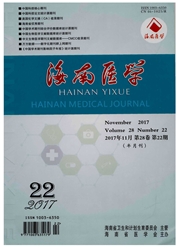

 中文摘要:
中文摘要:
目的比较一线的传统与新型的抗癫痫药物治疗新诊断癫痫患者的保留率,为癫痫患者维持治疗的药物选择提供依据。方法通过门诊随诊对269例新诊断的癫痫患者按发作类型随机给予苯妥英钠、丙戊酸钠、卡马西平、拉莫三嗪、托吡酯、奥卡西平单药治疗,比较它们的一年保留率,并详细记录停药原因。结果一年保留率统计,传统的抗癫痫药物分别为苯妥英钠63.5%、丙戊酸钠67.3%、卡马西平68.6%,新型的抗癫痫药物分别为拉莫三嗪88.5%、托吡酯74.5%、奥卡西平75%,传统与新型抗癫痫药物的一年保留率比较差异均有统计学意义(P〈0.05)。在停药的原因方面,传统抗癫痫药物(52.5%)比新型抗癫痫药物(26.7%)更容易因为药物副作用而停药,两者比较差异也有统计学意义(P〈0.05)。结论新型抗癫痫药物治疗新诊断癫痫患者的一年保留率较传统的抗癫痫药物高,提示对于新诊断癫痫患者应优先选择新型的抗癫痫药物作为单药治疗。
 英文摘要:
英文摘要:
Objective To compare the retention rate of traditional antiepileptic drugs and new antiepileptic drugs in the treatment of newly diagnosed epileptic patients, and to provide basis for drug selection of maintenance treatment. Methods A total of 269 epileptic patients newly diagnosed in the Outpatient Department were randomly given single drug therapy according to seizure types, including traditional antiepileptic drugs (Phenytoin, Sodium Val- proate, Carbamazepine) and new antiepileptic drugs (Lamotrigine, Oxcarbazepine and Topiramate). The retention rates were compared after one year, and the reasons for withdrawal in detail were recorded. Results The one year re- tention rates of new antiepileptic drugs Lamotrigine (88.5%), Oxcarbazepine (75%), Topiramate (74.5%) were signif- icantly different from those of traditional antiepileptic drugs Phenytoin (63.5%), Sodium Valproate (67.3%), Carbam- azepine (68.6%). Patients treated with traditional antiepileptic drugs (52.5%) were much more likely to withdraw than those treated with new antiepileptic drugs (26.7%) because of side effects. Conclusion The retention rate of new an- tiepileptic drugs is significantly higher than the traditional antiepileptic drugs in newly diagnosed epileptic patients. To select new antiepileptic drugs as first monotherapy for patients with newly diagnosed epilepsy is rational.
 同期刊论文项目
同期刊论文项目
 同项目期刊论文
同项目期刊论文
 期刊信息
期刊信息
